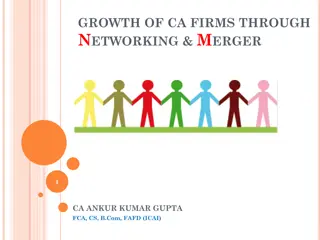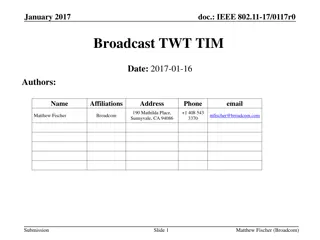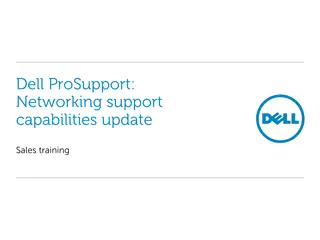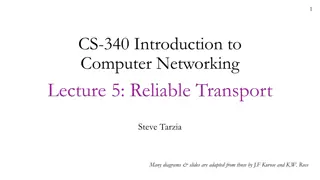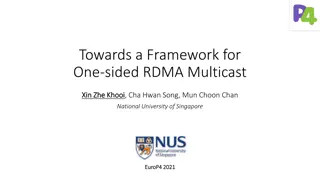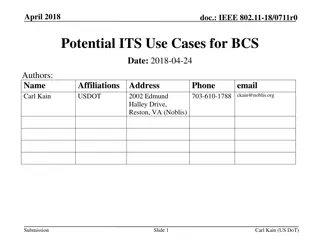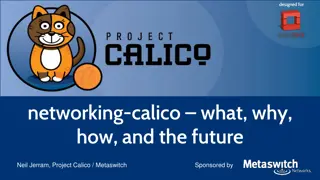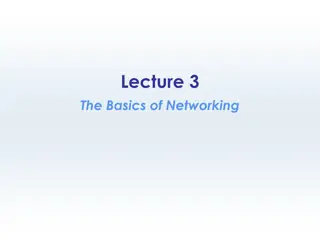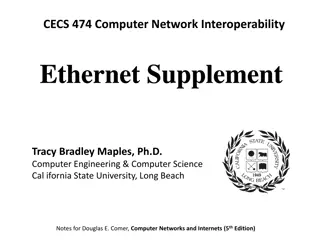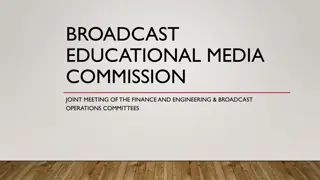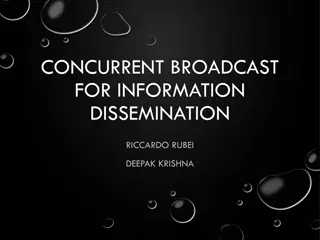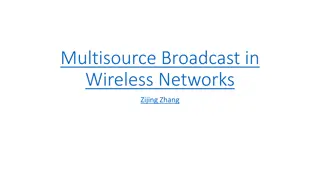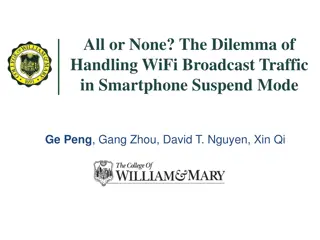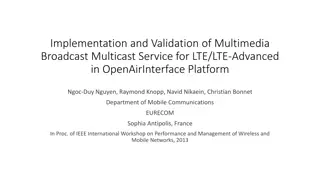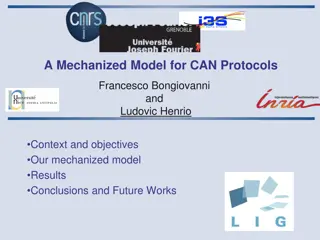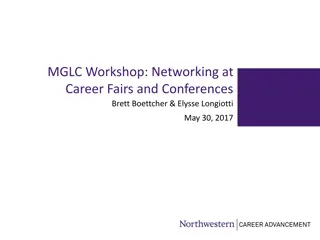Understanding Computer Networking: Broadcast and Multicast Protocols
In this lecture on computer networking, we explore the concepts of broadcast and multicast protocols. The discussion covers topics such as BGP routing, IPv4 anycast hack, IP multicast, and the role of broadcast in small-to-moderate sized ad hoc networks. Learn about the differences between unicast, anycast, geocast, broadcast, and multicast addressing in IP networks, and understand the challenges and benefits associated with each. Dive into the world of routing algorithms, packet delivery, and network structure optimization.
Download Presentation

Please find below an Image/Link to download the presentation.
The content on the website is provided AS IS for your information and personal use only. It may not be sold, licensed, or shared on other websites without obtaining consent from the author. Download presentation by click this link. If you encounter any issues during the download, it is possible that the publisher has removed the file from their server.
E N D
Presentation Transcript
1 CS-340 Introduction to Computer Networking Lecture 12: Broadcast Steve Tarzia
2 Last Lecture: BGP routing DV Count to infinity leads to slower convergence when links get worse. Good news travels quickly, bad news travels slowly. Internet routing is hierarchical. Autonomous systems (ASes) are grouped routers with one routing policy. An Interior Gateway Protocol (IGP) (eg., OSPF) determines optimal routes within an AS. Can use a centralized (Link State) shortest path algorithm, like Dijkstra s. The Border Gateway Protocol (BGP) determines routes between ASes. Uses a distributed shortest-AS-hop path algorithm (Distance Vector). BGP advertisement includes a list of routes, each looking like: {PREFIX: 43.5.0.0/16, AS-PATH: [AS4, AS65, AS1], NEXT-HOP: 5.6.7.200)} This tells a neighboring AS that it can forward packets to the prefix.
3 Generalized packet delivery IP networks were built for unicast addressing (sending a packet to a single destination address) but applications have more general needs: Unicast: to one node Anycast: to one of many possible nodes Geocast: to nodes in a specific location Broadcast: to all nodes Multicast: to a set of nodes
IPv4 anycast hack Remember, this is Google's public DNS server 4 The single IP address 8.8.8.8 maps to may different machines across the world, using a hack called IPv4 anycast. Multiple border gateways (routers) advertise short routes to 8.8.8.8. Within the AS, traffic is directed to the closest 8.8.8.8 instance. Below, there is nothing stopping two AS es from advertising short routes to the same IP address, thus creating two copies of the same IP address. BGP Hijacking is the malicious takeover of another AS es IP addresses. 8.8.8.8 3c 3a 8.8.8.8 3b 2c AS3 other networks 1c 2a 2b other networks 1a 1b AS2 1d AS1
5 IP Multicast (optional) Certain IP addresses are reserved to identify broadcast groups. Eg., 239.1.1.1. Traffic sent to that address is forwarded to every host that has subscribed to that broadcast group using Internet Group Management Protocol (IGMP). Adds burden to routers, since they must track all broadcasts active at that time. (To which neighbors should I forward multicast traffic?) More routing info to track (in addition to BGP) and with finer granularity. Public Internet routers generally do not support IP Multicast. Used in special scenarios for streaming content to many viewers. Eg., IPTV in hotels or video broadcast on a campus. Applications must use UDP, not TCP (because sender would have to track ACK status of thousands of receivers)
6 Broadcast as a basic network building block STOP and THINK IP (the Internet) does not support broadcast. Why? No one message is relevant to all hosts on the entire Internet! Broadcasts are crucial in small-to-moderate sized ad hoc networks: Networks of neighboring hosts that connect without prior planning. Also called mesh networking and MANETS. Firechat (2014 18) was a P2P chat app using bluetooth and ad-hoc WiFi. Broadcasts can be used to share information about network structure to later enable unicast routing.
7 How to implement link state (LS) flooding? Remember, a "link state" routing algorithms uses Dijkstra's algorithms to compute the shortest paths. Information on the whole network must be gathered in one place. Another way of looking at this is that any information about every link and node must be broadcast to everyone in the network.
8 Broadcasting (flooding) Na ve approach is to unicast the message to each node. Downsides? Requires prior knowledge of the full network and it is inefficient: STOP and THINK R1 R1 First hop has duplicates R2 R2 R3 R4 R3 R4 broadcast 3x unicast Broadcast allows a message to be duplicated in transit to reach different parts of the network. Must be careful to ensure: Correctness: all nodes get the message. Efficiency: ideally, message is received just once by each node Termination: message is not retransmitted forever.
9 How would you implement broadcast? Assume that each node just knows about its neighbors What challenges arise? STOP and THINK
10 Broadcast strategy #1: Controlled Flooding Nodes retransmit packet only the first time it is seen by a node. Obviously, don t retransmit it on the link it was received on. Id matches a message that we already saw. Do nothing! Node checks message id. It s new, so retransmit! New Later, the same message arrives again message How does a node tell that a packet is new ? Broadcast packets must contain a unique identifier. Nodes must remember all recently-seen message identifiers. In Link-State algorithm, when flooding link state, messages include: link source, link destination, sequence number, link cost uniquely identifies the message
11 LS flooding demo Why do we need sequence numbers?
13 Broadcast strategy #2: Spanning Tree In a graph, a spanning tree is a subset of edges that connects all the nodes and has no cycles (loops). To implement broadcast efficiently, flood message only along spanning tree. All nodes will be reached. Lack of cycles prevents duplication and guarantees termination. No need to remember message identifiers. But must somehow find a spanning tree, and all nodes must use the same spanning tree.
14 Simplest spanning tree algorithm Root DFS: |V| times, find an edge that does not create a cycle and add it to the tree. In more detail: Do a depth-first or breadth-first search for unvisited nodes, adding the connecting edges. Track the nodes already in the tree (visited) and ignore edges leading to those. Root BFS: Does not compute a minimal-cost spanning tree.
15 Minimum Spanning Tree Root Find a spanning tree such that the sum of all edge costs is minimized. This minimizes the total communication cost for broadcast. Prim s algorithm: Start with a root node. Repeatedly add the minimum-cost edge on the frontier of the tree. A frontier edge connects a node in the tree to a node outside the tree. See also: Kruskal s algorithm STOP and THINK How to efficiently find the min-cost frontier edge? = frontier edge
16 Shortest Path Tree A special spanning tree computed by Dijkstra s algorithm. Minimizes the path cost to every node Thus, minimizes the path cost to the farthest node from the root. If link costs represent latencies, shortest path tree minimizes the broadcast latency. Not a minimum spanning tree. Totaledge cost may be greater, but this is irrelevant for parallel message latencies. Minimizes the longest path in the broadcast. Root
17 Tradeoff between total cost and longest path Minimum Spanning Tree (eg., Prim's alg.) Total cost: 18 Longest path: 13 Best choice if edge costs are cumulative (eg., dollars, energy). Shortest Path Spanning Tree (Dijkstra) Total cost: 23 Longest path: 9 Best choice for broadcast if edge costs represent delays. Root Root
18 Broadcasting summary Controlled flooding Nodes re-broadcast new messages. Must track recently-seen messages. Duplicate messages may be received. It s simple and it works! A totally distributed approach. Spanning tree Sends messages only along necessary paths. Nodes do not get duplicates. No need for message id s. Communication cost or delay can be minimized. Requires centralized knowledge of full network (to run opt. alg.) All nodes must agree on a spanning tree, so they must have the same information. In the case of Internet routers, flooding is needed to share this full network knowledge.
19 Network design problems Would we ever want to build a shortest path tree network instead of an MST? STOP and THINK MST can be used for other problems in networking (and elsewhere!) Eg., given a list of cities and their locations, what is the cheapest way to build a network that interconnects them? Cities are nodes and distance between all pairs of cities are weighted edges. MST is the cheapest connected graph (network) that can be built.
20 Recap IP anycast: BGP trick to send traffic for one IP address to two hosts. Broadcasting is sending a single message to every host. Multicast is sending a single message to many (but not all) hosts. Controlled flooding: add a sequence number to messages, and retransmit only if you have not seen the received sequence number. Spanning tree: a graph without cycles that reaches all nodes. Broadcast can be done by transmitting along a spanning tree. Prim s algorithm constructs a minimum-cost spanning tree Dijkstra s algorithm constructs a shortest-path-from-root spanning tree


